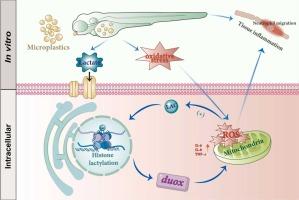微塑料通过roshstone乳酸化正反馈回路调节中性粒细胞迁移
IF 11.3
1区 环境科学与生态学
Q1 ENGINEERING, ENVIRONMENTAL
引用次数: 0
摘要
微塑料(MPs)因其显著的毒性作用而引起了人们的广泛关注。尽管先前的研究已经报道了它们对中性粒细胞功能的影响,但mp诱导的中性粒细胞迁移在活生物体中的实时可视化和调控机制仍未被探索。在本研究中,斑马鱼暴露于100 μg/L的MPs中,在3 h和6 h时,中性粒细胞向炎症部位的迁移分别增加1.7倍和1.5倍。转录组学分析表明,活性氧(ROS)和组蛋白乳酸化作用参与了这一过程。实验验证证实,MPs显著上调了乳酸化水平,相关基因(如ep300a、ep300b、ldha)和蛋白(Pan-Kla、H3K18la)增加了约50%。同时,促炎细胞因子(il-6、il-8、il-1β)升高近1倍,ROS水平升高1.4倍,氧化应激相关基因(sod2、gpx2)显著上调。用2DG抑制乳酸生成或用Dpi抑制氧化应激可使中性粒细胞迁移恢复到接近基线水平。机制上,乳酸化特异性ChIP-seq和ChIP-qPCR分析显示,H3K18la修饰促进了duox的表达,从而增强了ROS的产生。反过来,ROS进一步放大乳酸化,建立一个积极的反馈循环,共同推动中性粒细胞迁移。本研究首次实现了mp诱导的中性粒细胞在体内迁移的实时可视化,阐明了其ros -乳酸化相互作用机制,为了解mp的免疫毒性提供了新的见解和实验证据。本文章由计算机程序翻译,如有差异,请以英文原文为准。

Microplastics modulate neutrophil migration via an ROShistone lactylation positive feedback loop
Microplastics (MPs) have attracted considerable attention due to their significant toxic effects. Although previous studies have reported their impact on neutrophil function, the real-time visualization and regulatory mechanisms of MP-induced neutrophil migration in live organisms remain unexplored. In this study, zebrafish were exposed to 100 μg/L MPs, resulting in a 1.7-fold and 1.5-fold increase in neutrophil migration to inflammatory sites at 3 h and 6 h, respectively. Transcriptomic analysis suggested the involvement of reactive oxygen species (ROS) and histone lactylation in this process. Experimental validation confirmed that MPs significantly upregulated lactylation levels, with related genes (e.g., ep300a, ep300b, ldha) and proteins (Pan-Kla, H3K18la) increased by approximately 50 %. Concurrently, pro-inflammatory cytokines (il-6, il-8, il-1β) were elevated by nearly 1-fold, ROS levels were raised by 1.4-fold, and oxidative stress-related genes (sod2, gpx2) were significantly upregulated. Inhibition of lactate production with 2DG or suppression of oxidative stress with Dpi restored neutrophil migration to near baseline levels. Mechanistically, lactylation-specific ChIP-seq and ChIP-qPCR analyses revealed that H3K18la modification promotes duox expression, thereby enhancing ROS generation. ROS, in turn, further amplifies lactylation, establishing a positive feedback loop that collectively drives neutrophil migration. This study provides the first real-time visualization of MP-induced neutrophil migration in vivo and elucidates the underlying ROS-lactylation interaction mechanism, offering new insights and experimental evidence for understanding the immunotoxicity of MPs.
求助全文
通过发布文献求助,成功后即可免费获取论文全文。
去求助
来源期刊

Journal of Hazardous Materials
工程技术-工程:环境
CiteScore
25.40
自引率
5.90%
发文量
3059
审稿时长
58 days
期刊介绍:
The Journal of Hazardous Materials serves as a global platform for promoting cutting-edge research in the field of Environmental Science and Engineering. Our publication features a wide range of articles, including full-length research papers, review articles, and perspectives, with the aim of enhancing our understanding of the dangers and risks associated with various materials concerning public health and the environment. It is important to note that the term "environmental contaminants" refers specifically to substances that pose hazardous effects through contamination, while excluding those that do not have such impacts on the environment or human health. Moreover, we emphasize the distinction between wastes and hazardous materials in order to provide further clarity on the scope of the journal. We have a keen interest in exploring specific compounds and microbial agents that have adverse effects on the environment.
 求助内容:
求助内容: 应助结果提醒方式:
应助结果提醒方式:


